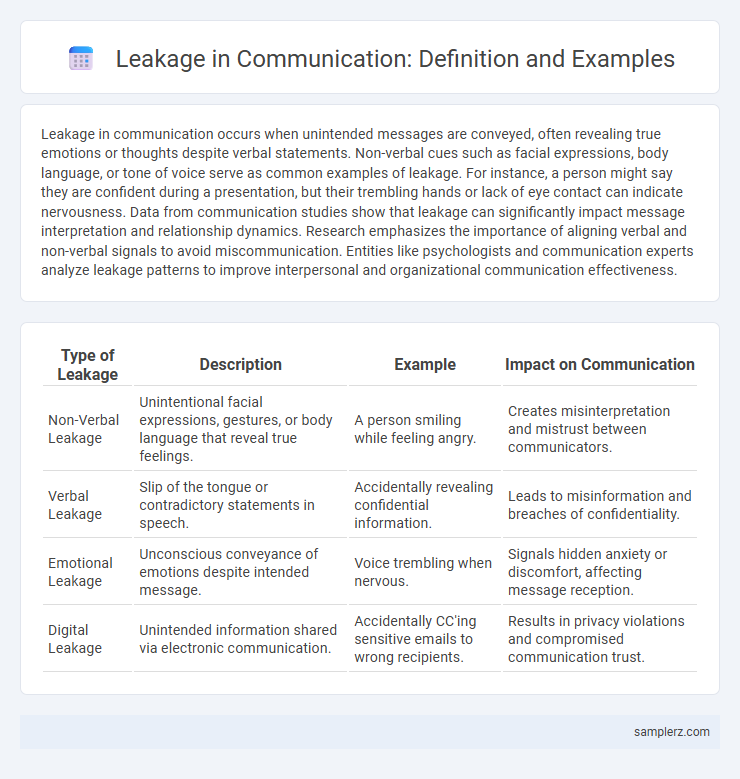Leakage in communication occurs when unintended messages are conveyed, often revealing true emotions or thoughts despite verbal statements. Non-verbal cues such as facial expressions, body language, or tone of voice serve as common examples of leakage. For instance, a person might say they are confident during a presentation, but their trembling hands or lack of eye contact can indicate nervousness. Data from communication studies show that leakage can significantly impact message interpretation and relationship dynamics. Research emphasizes the importance of aligning verbal and non-verbal signals to avoid miscommunication. Entities like psychologists and communication experts analyze leakage patterns to improve interpersonal and organizational communication effectiveness.
Table of Comparison
| Type of Leakage | Description | Example | Impact on Communication |
|---|---|---|---|
| Non-Verbal Leakage | Unintentional facial expressions, gestures, or body language that reveal true feelings. | A person smiling while feeling angry. | Creates misinterpretation and mistrust between communicators. |
| Verbal Leakage | Slip of the tongue or contradictory statements in speech. | Accidentally revealing confidential information. | Leads to misinformation and breaches of confidentiality. |
| Emotional Leakage | Unconscious conveyance of emotions despite intended message. | Voice trembling when nervous. | Signals hidden anxiety or discomfort, affecting message reception. |
| Digital Leakage | Unintended information shared via electronic communication. | Accidentally CC'ing sensitive emails to wrong recipients. | Results in privacy violations and compromised communication trust. |
Understanding Leakage in Communication
Understanding leakage in communication involves recognizing unintentional signals that reveal true feelings or thoughts, such as inconsistent body language conflicting with spoken words. For example, a speaker claiming confidence while avoiding eye contact or displaying nervous gestures may inadvertently disclose anxiety or doubt. These nonverbal cues can undermine the intended message and affect the accuracy of interpersonal understanding.
Common Types of Communication Leakage
Common types of communication leakage include unauthorized disclosure of confidential emails, inadvertent sharing of sensitive information during meetings, and improper handling of secure messages on digital platforms. Such leaks often occur through phishing attacks, weak password protection, or accidental forwarding of private documents. Organizations must implement robust encryption protocols and employee training to mitigate these risks.
Nonverbal Leakage: Unintentional Body Language
Nonverbal leakage occurs when unintentional body language reveals feelings or thoughts that contradict spoken words, such as crossed arms indicating defensiveness during a supposedly open conversation. Microexpressions, subtle facial expressions that flash briefly, can betray true emotions like anger or discomfort despite verbal reassurances. These involuntary cues can undermine trust and clarity, leading to misunderstandings in interpersonal communication.
Verbal Cues: Leakage through Words and Tone
Verbal cues often reveal true emotions despite attempts to conceal them, with inconsistencies between spoken words and tone serving as key indicators of leakage in communication. For instance, a sarcastic tone conveying annoyance undermines polite verbal expressions, signaling underlying frustration. Detecting such dissonance between word choice and vocal inflection helps identify concealed feelings and improves interpersonal understanding.
Digital Communication Leakage: Emails and Messages
Digital communication leakage often occurs when sensitive emails or messages are unintentionally sent to incorrect recipients, exposing confidential information to unauthorized parties. Phishing attacks and unsecured messaging platforms increase the risk of data breaches by intercepting or accessing private communications. Implementing encryption protocols and strict access controls significantly reduces the vulnerability of email and message transmissions.
Leakage in Formal Meetings
Leakage in formal meetings often occurs when sensitive information is unintentionally disclosed through non-verbal cues such as body language, tone of voice, or facial expressions. Participants may also reveal confidential details by speaking off-topic or during informal side conversations. Effective communication protocols and confidentiality agreements help minimize the risk of such leakage.
Leakage during Public Speaking
Leakage during public speaking often occurs through involuntary body language such as fidgeting, avoiding eye contact, or inconsistent facial expressions, which can reveal nervousness or lack of confidence. Vocal tone changes, unintended pauses, or speech disfluencies may also leak underlying emotions like anxiety or uncertainty to the audience. These nonverbal and verbal leakages can undermine the speaker's intended message and reduce the effectiveness of communication.
Cultural Leakage in Cross-Cultural Communication
Cultural leakage in cross-cultural communication occurs when implicit biases or unintentional cultural cues cause misunderstandings, such as misinterpreting body language or idiomatic expressions. For example, a gesture considered positive in one culture may be offensive in another, leading to breakdowns in trust and cooperation. Recognizing and addressing these subtle cultural differences is crucial to preventing communication leakage and enhancing mutual understanding.
Impact of Leakage on Workplace Communication
Leakage in workplace communication often manifests as unintentional disclosure of sensitive information, undermining trust and collaboration among team members. This breach can lead to decreased morale, disruption of workflow, and heightened conflicts, ultimately impacting overall productivity. Addressing leakage through clear protocols and secure communication channels is crucial to maintaining a transparent and effective workplace environment.
Strategies to Prevent Communication Leakage
Effective strategies to prevent communication leakage include implementing secure communication channels such as end-to-end encryption and regularly updating access controls to restrict unauthorized information flow. Training employees on data confidentiality and encouraging transparent reporting processes reduce the risk of accidental or intentional leaks. Establishing clear protocols for handling sensitive information and conducting periodic audits ensure vulnerabilities are identified and mitigated promptly.

example of leakage in communication Infographic
 samplerz.com
samplerz.com